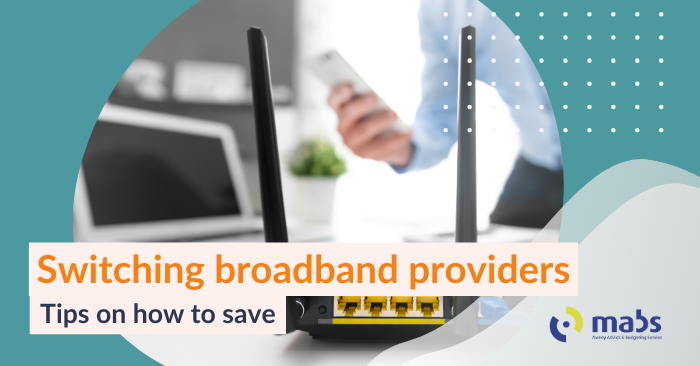Switching Broadband Providers – Tips on How to Save
Did you know most broadband & TV packages run on 12-month contracts? This means we should look for a better deal every year, even from the same provider. With seemingly non-stop increases over the past couple of years, it makes sense to be savvy and make savings where possible. With all the different streaming services available, along with confusing broadband and TV packages, taking a moment to take stock of what you are paying for and what you actually use can free up some money to go on more important things.
Switching does not have to be complicated, but it takes some know-how. It will become second nature once you’ve gone through the process.
Below, we explain what you need to do to get started, what options to consider and how to switch your TV/broadband package.
Get prepared!
- Locate your latest TV/broadband bill and see what plan or tariff you’re currently paying for. You may need to log in to your online account to get your bill if you’ve signed up for paperless billing.
A current bill will also list your landline number (even if you’re not using a landline. If you’re using mobile broadband, there will be a mobile number on your bill) and your UAN number (which may also be your account number, depending on your provider). This will help speed up your switching process. - Know your Eircode.
This might be on your bill, but if not, look it up on the Eircode finder. This helps your broadband provider locate your house to ensure they connect to the right house. - If you sign up for a direct debit, have your bank details (IBAN and BIC) in hand.
- List out what streaming services you are paying for and note which ones you use. Some packages may include streaming services built-in or as a “freebie”.
Make Decisions
Great, now you’re ready to start looking for the best deal:
- Decide if you want an all-inclusive package. That can include TV, broadband, landline, and, in some cases, mobile phone plans and streaming services.
- Decide if you are changing your current package. Do you want to remove any extras/add-ons (sports package, streaming services like Netflix, NowTV, Disney+ or Amazon Prime Video or additional connections such as a second TV), increase your WIFI speeds, or change phones? (if you have mobile built into your current package).
- What is your budget for this monthly cost? Can you afford to increase it, or are you looking to make savings? Once you know your budget, stick to it.
- Depending on your budget, decide if you want any add-ons. For example, a sports package, movie package, or additional streaming services.
Be sure to
- Check when your contract is due for renewal. If not, you may incur “exit fees” for breaking the contract. These may make it cheaper to move at the end of your contract (so set a reminder!)
- When looking at deals, note how long the discount is for and how long the contract is for. If they are different lengths of time, check what rate you’ll be moved to after the discount period.
- A lot of providers are now including a yearly inflation increase, meaning that no matter what plan you’re on, at an agreed time of the year, for example, from April, your monthly price will increase by 7% – be sure to check whether this is included in the contract and budget accordingly.
- If there are add-ons included for a limited time, e.g. 3 months of free Netflix or sports channels, check the monthly price of these. If you opt for these packages – set a reminder on your calendar to cancel them before you are charged (if you want to cancel – and if it’s possible,check the small print as it may state that by accepting the 3 months free you are signing up for the duration of the contract).
- Many TV/Broadband providers offer deals for 6 months on a 12-month contract. Check that you can afford the increase 6 months down the road. Set a reminder so you don’t get shocked. It could cost you those initial savings, and as you have entered a contract, making any changes to your plan can be costly.
When/After Switching
- Be sure to align your current supplier’s end date with the installation/start date of your new contract/supplier. The best way to do this is to notify your current supplier after you’ve received a delivery or installation date from the new provider (as suppliers can take up to 30 days, and you may need to give 30 days’ notice to your current supplier).
- Return your current supplier’s equipment. They may arrange this for you, but if they don’t and you do nothing, you can get charged for not returning them.
Now you’ve got everything together and know what to consider and what options you want, it’s time to search for the best deal. Here are some price comparison websites to help make the switch easier.
Comparison websites
Switching your broadband provider, car insurance, energy provider, and even your bank account can be daunting the first time you do it. However, following the steps we’ve outlined will make the process easier every time you follow them. We hope you’ve learned something new and feel empowered to switch when your contract is up!
Contact Us
If you have a query for one of our advisers or are struggling with your debts, you can call the MABS National Helpline on 0818 07 2000 Monday to Friday, from 9am to 8pm, or find the contact details for your local office. More information is available on our website.
Disclaimer: This blog does not represent legal guidance and is intended for guidance only. This blog is intended to assist you to make your own decisions and we will never suggest you use one provider over another.
Note: We welcome references to and use of the content in this blog. However, please reference MABS, and link said content if you choose to do so.
Updated: 08/04/2024





Facebook
twitter
Instagram